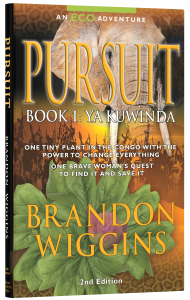COMMUNITIES
Excerpt from PURSUIT: Ya Kuwinda.
This is Book #1 in Brandon’s Pursuit Series.
The newly-revised 2nd Edition was released in 2018.
 Harper pictured the dynamic Dr. Merrill leading his class. When he lectured in the areas of his passion, no professor was more riveting or intellectually stimulating. She was inspired by his presentations, enthralled by the purity of his intent:
Harper pictured the dynamic Dr. Merrill leading his class. When he lectured in the areas of his passion, no professor was more riveting or intellectually stimulating. She was inspired by his presentations, enthralled by the purity of his intent:
Plant communities and their health are the crucial elements of natural survival. Take the plight of the commercially produced strawberry. Driscoll Inc. has, as we speak, 180,000 acres of strawberry fields grown with one and only one variety of fragaria. This is called monoculture: Note: this will be on the midterm.
The result in the case of predators, including fungus, insects, virus, and bacteria, is that when any plant in the group gets infected, the rest of the population is not only susceptible, but likely to succumb. The grower has to overdose the fields with methyl bromide to combat crop devastation.
The purpose for plant communities is that different varieties exhibit different growing habits, harbor beneficial predators, attract a variety of pollinators … well, the list is endless. In the natural arena, speaking generally, one variety will house the insect or bacteria that will inhibit the pest of its neighbor. Another good neighbor may drop seed pods that can alter the local pH, stalling a bacterial infection.
Perhaps more importantly, each member of the plant community occupies a different niche. In a natural habitat, you have the arboreal members, the vining members, the low semi-herbaceous shrubs, the taller woody shrubs, the annuals, the perennials, etc. Each member inhabits its own area of expertise in order to thrive. It is imperative for the habitat that each position be filled and functioning.
Human communities are no different. If all the members of the community have the same function, who will harbor the beneficials? If we have all annuals, what will the pollinators and predators do during the dormant season without perennials? Nature is, by design, a place for all different types of inhabitants. If a habitat shuns one of its natives, the community is out of balance and will eventually expire.
I guarantee the concept of ‘tolerance’ was not ever an issue in a natural situation. If you fulfill your niche in your own community, you will thrive and be a crucial contribution to the whole.